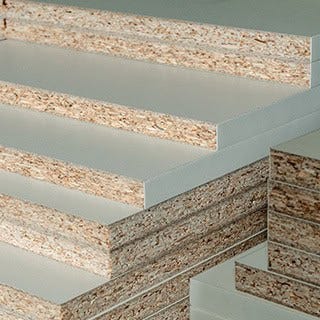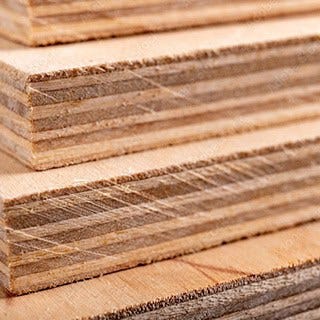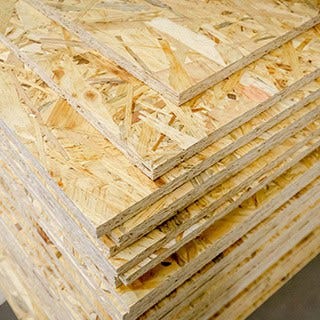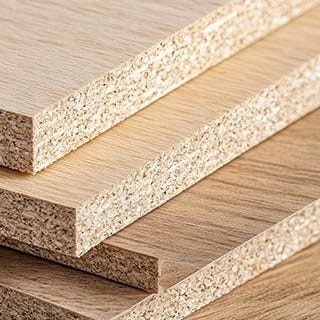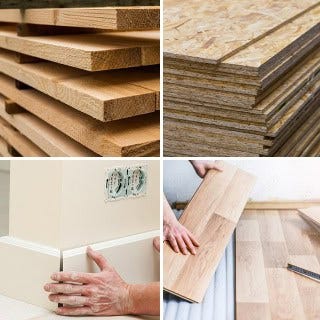OSB Boards: What Are They and How Are They Used
OSB boards have become one of the most popular engineered wood products due to their high strength and low cost. They are used for wall and roof sheathing, alongside internal walls, flooring, and furniture. In this guide from Building Materials Nationwide, we’ll explore the benefits and drawbacks of OSB boards, how they’re graded, and their popular uses within construction and furniture.
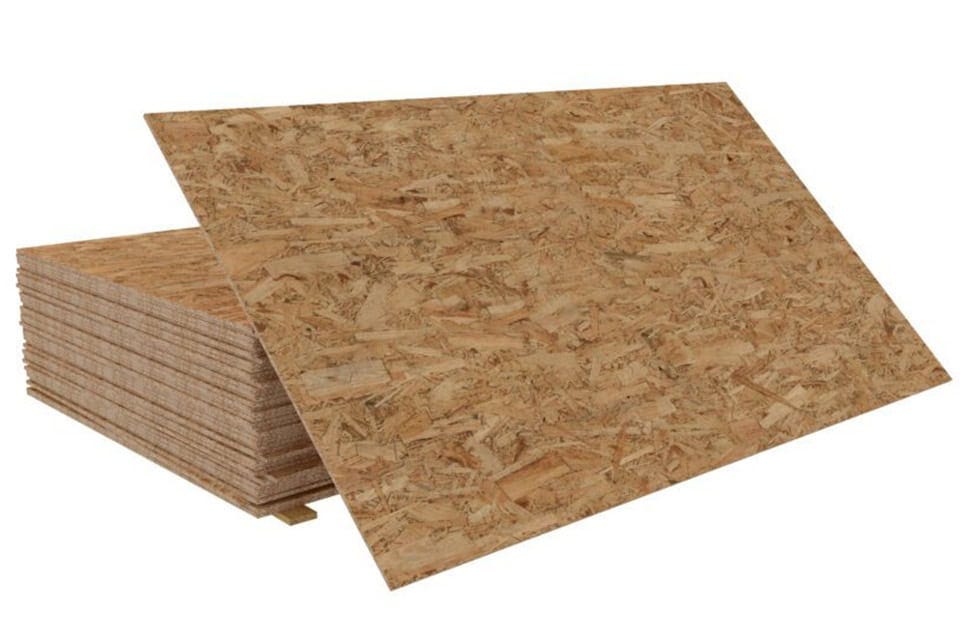

What is an OSB Board?
OSB boards, short for oriented strand boards, are an engineered wood product used within construction. In terms of manufacture, they are comparable to both plywood and chipboard. They are produced from sheets of timber strands, that will be placed on top of each other at 90-degree rotations during the manufacturing process, and will then be attached to one another with adhesives, before being bonded with heat and pressure. Since their invention in the early 1960s, they have grown to be a popular building material due to their reliability, strength, and price point.
The Benefits of Using OSB Boards
OSB Boards have grown in popularity over the recent past, due to the key benefits they bring to building projects of various sizes.
- High Strength: OSB boards are designed with strength in mind, and they offer among the best performances from an engineered wood product, with a higher shear strength than plywood. This means they can be used in a wide variety of construction projects. Despite being made from strands rather than veneers, they will give a superior strength performance to plywood and other products like MSB and chipboard.
- Cost-Effective: Despite its great levels of strength, OSB boards will be cheaper than plywood, further making them viable for a lot of uses such as sub-flooring within a building project.
- Strong Lifespan: The lifespans of engineered woods can often be a key drawback, but OSB panels boast a longer lifespan, offering 30 to 60 years of dependable performance. This further makes them a cost-effective choice, as they will not need to be replaced as often.
- Sustainable: The wood strands used to make OSB boards are typically sourced from sustainable forests, with all parts of the log used to minimise waste.
- Large Sizes: The size of a plywood panel will be inherently limited by the size of a tree, as each veneer will need to be cut whole. Because OSB boards are made from strands of wood they can be produced in larger sizes. OSB manufacturers will produce boards in sizes of up to 2440mm x 7320mm, with some offering custom sizing.
Combining great strength with a competitive price point has allowed OSB boards to gain an increasingly large share of the engineered wood market. However, there are a few drawbacks to keep in mind when looking for the ideal product for your building project.
- High Weight: The density of OSB boards gives them a heavier weight than plywood, meaning that transportation and handling will all be more difficult.
- Issues With Moisture: While early OSB boards had severe issues with moisture, these have been largely addressed with the adhesives and resins used in contemporary boards, but there can still be issues with swelling at the sides, especially when cut. They are not suited to exterior use in most cases.
- Visual Issues: Standard OSB boards are not aesthetically pleasing, compared to plywood which has the look of real wood. This means that OSB boards will often need to be obscured or painted when used.
How Are OSB Boards Graded?
There are four separate grades of OSB board set out under European standards, relating to both the strength performance rating and the moisture resistance:
- OSB1: A general-purpose OSB board, made for interior uses such as furniture, specifically in dry conditions.
- OSB2: A load-bearing board for use in dry conditions.
- OSB3: A load-bearing board for use in humid conditions.
- OSB4: A heavy-duty load-bearing board for use in humid conditions.
The best grade for your project will vary depending on needs, with OSB3 probably the most popular choice in the UK, due to its strength and moisture resistance. Some boards will also be designated as zero or OSB0, to show that they do not contain formaldehyde.
Are OSB Boards Waterproof?
While modern OSB boards can offer good performance in humid environments, wood products are never fully waterproof. In damp interior environments opting for an OSB3 or OSB4 should be good enough, and these can be used outside, but there will be issues should moisture level rise about 20%. You can use a primer to further benefit this, but OSB boards are not traditionally used exposed in outdoor environments.
Are OSB Boards Dangerous?
Traditionally, resins containing formaldehyde have been used within the production of OSB boards, which can cause a variety of health issues when released into the air. Within the EU there are strict laws governing the urea-formaldehyde content of an OSB board, and many contemporary options do not include formaldehyde at all, as indicated by OSB0 or Zero within their product description.
What Are OSB Boards Used For?
The strength and consistency offered by OSB boards have made them popular throughout the construction world, for a variety of non-visual uses. They are also used to create strong furniture.
Wall Sheathing
OSB boards are popularly used as external sheathing on timber homes, much as plywood has historically been used. OSB boards offer great strength and hold nails well. When looking to buy boards for external wall sheathing, it’s important to opt for the moisture resistance of OSB3 or OSB4.
Loft Boarding
OSB boards can be used for loft boarding within a building, creating a boarded surface that can be used for storage or as a loft conversion. OSB boards offer a high level of strength, which can be especially useful in a conversion, ensuring that the joists of your loft are protected and things like a bed and wardrobe can be held in place.
Flooring
OSB boards can be used as flooring, typically sub-flooring covered with a more aesthetically suitable flooring product. The strength of OSB boards makes them ideal for firm support in a heavy-traffic environment. If looking to install OSB as underflooring within a high moisture environment like a kitchen or bathroom, it’s important to choose a moisture-resistant model.
Roof Decking
Much like wall sheathing, OSB boards can also be used to form the roof sheathing of a timber-framed home. The strength and moisture resistance offered by high-grade roofing boards make them a great alternative to plywood roofing, and they’ll also come at a lower price point.
Internal Wall Sheathing
Lower strength grades of OSB can also be a great way to give a consistent covering to an internal wall, which can then be decorated in a variety of ways. If looking to use internal wall sheathing within a humid environment then you will need to opt for a moisture-resistant model.
Furniture
While a lot of furniture can be made from weaker engineered woods like MDF, for items where strength is needed OSB boards can be an excellent choice. This could be everything from chairs, tables, benches, or sturdy cabinets. OSB furniture will retain its unique look, which may not be to all tastes but can be painted if needed.
What Sizes of OSB Board are Available?
The most common size of OSB board will be 2440mm x 1220mm, but due to the way it is produced there will be larger sizes available if needed, alongside custom-sized boards. The thicknesses of the panel can also vary, with options like 9mm, 11mm, 12mm, 15mm, and 18mm available for sale.
How Do You Cut an OSB Board?
OSB boards can be cut similarly to plywood, using a table saw with a large number of teeth to cleanly cut through it. When cutting OSB boards or other similar engineered wood products it's important to prioritise safety. You should cut in a well-ventilated room, using a full gas mask and safety goggles. Cutting OSB boards, particularly when they contain formaldehyde, will throw up wood particles that can irritate. You’ll need to sand and seal the edges you have cut, especially if using a water-resistant model.
Painting OSB Boards
OSB boards can be painted when looking to use them for visual purposes. You’ll first need to lightly sand the face, and vacuum the surface. Then you’ll need to apply two coats of sealant to ensure that the paint isn’t absorbed into the board. If looking for a smoother surface, you can apply a resin filler coat to the OSB board, which can be a time-consuming process to achieve. If using a filler this will also need to be primed before painting. Oil-based paint will give a good look to your OSB, compared to water-based options which can cause some issues. You’ll need to apply two to three coats.
Our Range of OSB Boards
Building Materials Nationwide aims to take the hassle out of sourcing building supplies, offering a wide range of supplies, delivered across the UK, all sold at competitive prices. We work across the building industry, offering a selection of OSB boards for sale through our website. Our full range of engineered wood products includes chipboard & fibreboard, MDF, OSB and plywood. Customers in the industry can take account of our trade accounts, gaining access to our full supplier network, express delivery options, and the services of a dedicated account manager. Sign up for a trade account through our website today.
Buy top-notch Gyproc moisture resistant plasterboard
Building Materials Nationwide offers a wide selection of compliant Gyproc moisture resistant board options. It is perfect for use with tiles and in damp or humid areas such as bathrooms and kitchens.
Our materials adhere to industry standards, providing reliable performance and durability. With quality options from top manufacturers like British Gypsum and Knauf, you can trust us for your moisture resistant plasterboard materials.
Building Materials Nationwide offers convenience and streamlined ordering when you open a trade account. Enjoy competitive trade prices, speedy deliveries and flexible credit terms subject to eligibility.
The dedicated trade account management team supports you in finding the right products and ensuring your projects meet all regulatory requirements. Partner with us for seamless access to high-quality building materials. Sign up now or contact us for a chat.
More like this
- Your Best Options for Stud Wall Insulation
- Loft Insulation Installation: Trade Tips and Common Mistakes
- Everything You Need to Know About Foam Board Insulation

